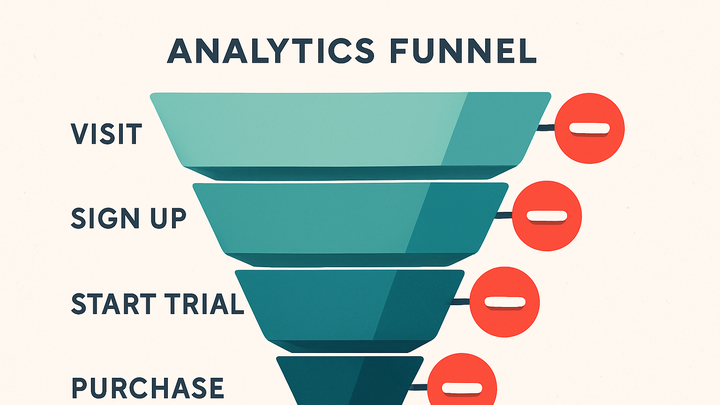Published on 2025-06-22T03:04:41Z
What is Drop-off? Examples of Drop-off in Analytics
Drop-off is a key metric in digital analytics that indicates the stage at which users exit a predefined flow or funnel without completing a desired action. It measures the difference between the number of users who start a process—such as signing up, purchasing, or completing a form—and the number who advance to subsequent steps. Drop-off is commonly analyzed in multi-step processes, like checkout flows or onboarding sequences, to highlight friction points that hinder conversions. By quantifying where users abandon a path, analysts can pinpoint usability issues, confusing page layouts, or technical errors. In popular SaaS analytics tools like Google Analytics 4 (GA4), drop-off rates can be visualized in the Funnel Exploration report. Privacy-focused solutions such as PlainSignal offer cookie-free funnel tracking to measure drop-offs while respecting user privacy. Effective drop-off analysis drives iterative improvements, leading to higher conversion rates and a smoother user experience.
Drop-off
The stage in a user journey or funnel where visitors leave before completing a desired action.
What Is Drop-off?
Drop-off refers to the point in a multi-step user journey where a visitor leaves the process before completing a desired action. It is measured by comparing the number of users at one step of a funnel to the number at the next. Frequent drop-offs can signal friction points, confusing content, or technical barriers. Understanding drop-off behavior is essential for optimizing user journeys and improving conversion rates.
-
Definition in analytics
In analytics, a drop-off occurs when a user exits a funnel or workflow at a specific step without moving forward. It is often expressed as a percentage of users lost between stages.
Why Drop-off Matters?
Analyzing drop-offs helps teams understand where users are disengaging, enabling targeted optimizations. By focusing on high drop-off points, organizations can improve conversion funnels, increase revenue, and enhance overall user satisfaction.
-
Impact on conversion
High drop-off rates directly reduce conversion volume and potential revenue. Identifying bottlenecks helps minimize lost opportunities.
-
Insight into user behavior
Drop-offs reveal where users encounter confusion, form fatigue, or performance issues. This insight guides UX, content, and technical improvements.
Tracking Drop-offs with SaaS Tools
Various analytics platforms provide built-in funnel analysis to measure drop-offs at each step. Below are examples using GA4 and PlainSignal.
-
GA4 funnel exploration
Google Analytics 4 offers the Funnel Exploration report in the Explore section. Define each funnel step—such as page views or custom events—and GA4 will display drop-off counts and rates between stages. Ensure your website is tagged with the GA4 measurement ID to collect the necessary data.
-
PlainSignal cookie-free analytics
PlainSignal provides simple, privacy-friendly funnel tracking without cookies. Insert their minimal script and define steps via CSS selectors or event bindings. Example embed code:
<link rel="preconnect" href="//eu.plainsignal.com/" crossorigin /> <script defer data-do="yourwebsitedomain.com" data-id="0GQV1xmtzQQ" data-api="//eu.plainsignal.com" src="//cdn.plainsignal.com/plainsignal-min.js"></script>Once installed, configure your funnel in the PlainSignal dashboard to see drop-off rates per step.
-
Installation
Copy the snippet above into your site’s
<head>section to start tracking user interactions. -
Configuration
Use the PlainSignal dashboard to set up funnel steps by specifying page URLs or element-based click events.
-
Strategies to Reduce Drop-off
After identifying drop-off points, apply optimization tactics to guide more users through the funnel. Regular monitoring and testing ensure sustained improvements.
-
Ux optimization
Simplify navigation, streamline forms, and improve page load times to reduce friction and keep users engaged.
-
A/b testing
Experiment with different layouts, copy, and button designs to determine which variants minimize drop-offs.
-
Clear calls-to-action
Use concise, action-oriented language and prominent buttons to guide users smoothly to the next step.
